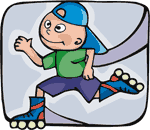Choosing skating equipment for juniors
 Some points about choosing skating equipment for juniors:
Some points about choosing skating equipment for juniors:
Since inline skating became popular in the early 1990s, many manufacturers have produced low-price copycat products which are available at a very low price. This has resulted in a wider range of choices for parents, but remember that you get what you pay for.
A pair of good qualify adjustable inline skates for children, made by a reputable inline skate manufacturer like Rollerblade and K2 , (these are currently the Nike and Adidas of skating products)will cost between S$150 to $300. You will be able to find skates at as cheap as $59 in certain big department stores. Many parents buy the low-priced products because they can’t tell the difference between good and poor quality skates. I will compare them here, part by part.
A)Skate boot:
Good quality:
a single or double piece synthetic material, which should feel and fit like a pair of running shoes. The foam should be SOFT, PLUSH and THICK. This will hug the feet, ensuring good fit, comfort, and avoiding compression muscle aches or blisters.
Poor quality:
Plastic outershells encasing a thin liner. Liner is removable, and often made of thinly padded foam, which gets compressed with repeated use. These boots are painful to use, because the hard shell boots compress and rub against the skin and muscles through the thin liners. Poor fitting also affects the skating motion and balance. The most common symptom of poor quality boot is if the ankles are consistently tilted outside or inside (not straight/vertical) even when a correct sized skate is properly worn.
b)Skate frame (the part that holds the wheels)
Good quality:
light Aluminum/Magnesium alloy or high quality composite plastics. These are durable, light, and stiff. They transmit power through the frame resulting in an efficient stride. End result is a faster skate with the same effort.
Poor quality:
Heavy plastics with poor molding, often with rough or sharp edges OR thick aluminum frames which are cumbersome and heavy. These frames transmit power poorly, and are often heavy. The result is an exhausting skate, and a constant feeling that one is not going fast enough for the same effort.
C)skate bearings
High quality:
ABEC/SG/ILQ rated 3 or 5, made by a reputable brand. These are high precision parts which spin efficiently, resulting in a smooth glide with little effort.
Poor Quality:
ABEC/SG/ILQ rated 3 or 5, made by an unbranded manufacturer, or unrated bearings. These are often slow to roll, resulting in a slow, tiring skate.
D)Skate wheels
High quality:
polyurethane made by a reputable inline skate or wheel manufacturer. With this you get high rebound, and a smooth, efficient roll. They also grip the ground firmly even when cornering or on wet ground.
Poor quality:
hard plastics which makes a "clack, clack" sound when it hits the floor, OR low quality polyurethane which have low grip and wears away quickly. Hard plastics in the wheels transmit shock from the ground to the ankles and knees, which increases the chance for injury for long term use. Poor material means reduced grip, increaseing the chances of falling due to sudden loss of friction on wet ground or when making a turn.
Skate specialty stores often refer to low-quality skates as "toys". You can tell that a skate is really a toy if a very young child can step around (with little or no roll) in the skate without learning to skate. Skates of low quality can cause discomfort, resulting in the child not enjoying the sport, or cause outright injury. Whereas skates of proper quality will let the child focus on learning the sport with little or no equipment distractions.

Thanks for sharing :)
Thanks for sharing 🙂
Remind me of my great skating time
thk u for sharing.
Yr article reminds me of the great time I had when I was skating with my friends few years ago.
thanks for sharing. can
thanks for sharing.
can recommend some quality brand, but in relatively reasonable price?
how to know when it is time to change the wheels?
hi
great guide !
how do we know when it is time to change the wheels?
😀